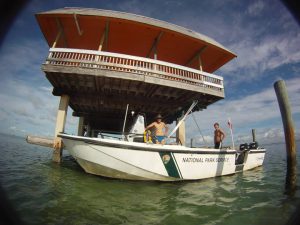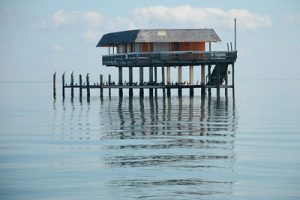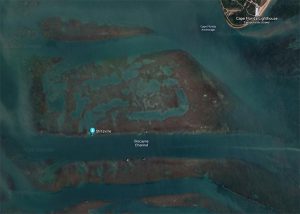“And then there were six.” This was the quote that started my day, on my friend Gary’s Facebook page. Instantly, I knew what this must mean, and with dismay, I clicked on the link he posted. I learned that today, January 11, 2021 after 7:15am, firefighters responded to flames at the LeShaw house, one of the seven remaining houses that comprise Stiltsville. Stiltsville is an iconic place, just two miles of the coast of Key Biscayne, surrounding Biscayne Channel. Stiltsville is aptly named for the houses built on stilts over the shallow seagrass beds and sand flats that surround the Safety Valve, an inlet area that connects Biscayne Bay to the Atlantic Ocean. I carry a great affinity and fascination for Stiltsville, after I was first introduced to the area as a graduate school intern in 2013.

The alluring history of Stiltsville dates back to the late 1920’s/early 1930’s, when a man named Eddie “Crawfish” Walker first brought barges to this area, to set up bait shops and a place to gamble. It later grew to be private clubs and weekend residences. At its peak in the 1960’s, there were almost 30 houses in the area, home to all sorts of activities. If one tries to research Stiltsville, it is quite difficult to find substantial information on the area’s history. In 1985, the submerged land under the houses was deeded to Biscayne National Park. In 2003, the Stiltsville trust was created (nps.gov/bisc). The Trust and Biscayne National Park have a memorandum of agreement to preserve the remaining structures, promoting Miami’s history, as well as, awareness of the rich biodiversity of species and habitats within the Park. Some of the houses are available for public use, through permit only. Over time, fires, hurricanes and exposure took down the majority of the houses.

I have extremely fond memories of learning how to boat in these waters, and how to navigate around the shoals to do lionfish surveys around the pilings of the houses. Each house has its own tricky set of navigational requirements, which really forces one to rely upon all their senses when driving around them. I received my first lionfish sting and envenomation at the Miami Power Boat Springs house my first week on the job. The allure of Stiltsville continued to captivate me ever since, and I wave at the houses every time that I’m in the area boating, visiting Bill Baggs Cape Florida State Park, or walking through Kennedy Park or Coconut Grove.

Preliminary reports indicate that thankfully, there were no injuries or fatalities as a result of the LeShaw house fire. However, due to protections afforded by the National Park Service and other regulatory challenges, it is highly unlikely that the house will be re-built. Until today’s fire, these seven houses (A-Frame, Baldwin Sessions, Bay Chateau, Ellenburg, Hicks, LeShaw, and Miami Springs Power Boat Club) survived the 28 years after Hurricane Andrew. These houses and their predecessors were witness to Miami’s history for almost the past 100 years.
And then there were six.
 0
0
